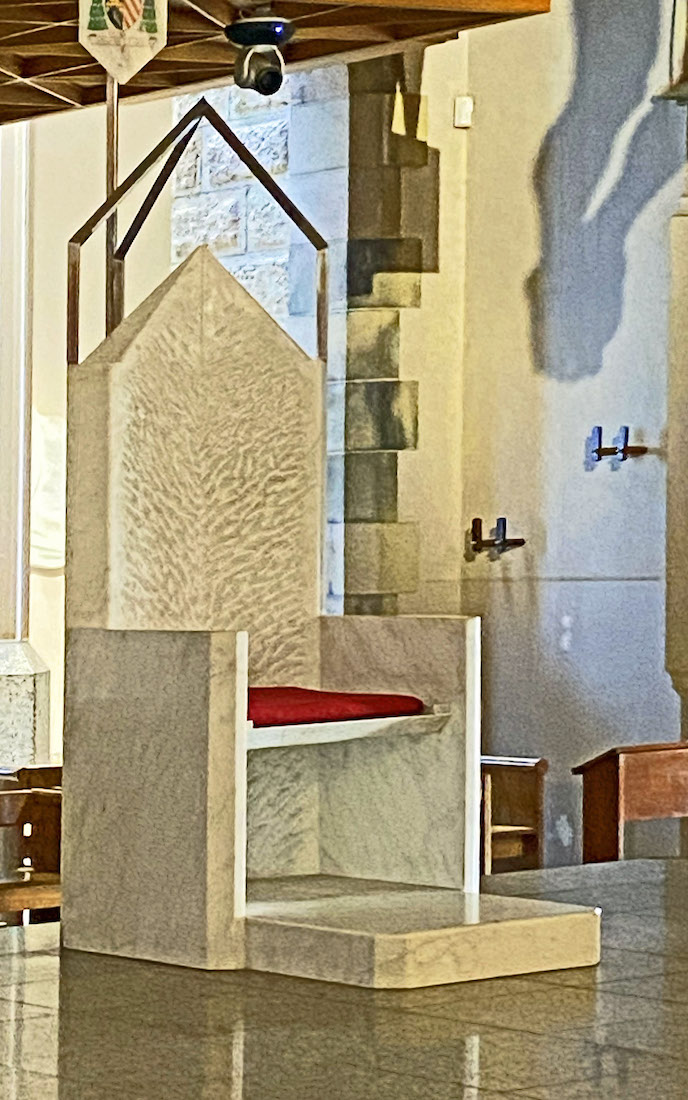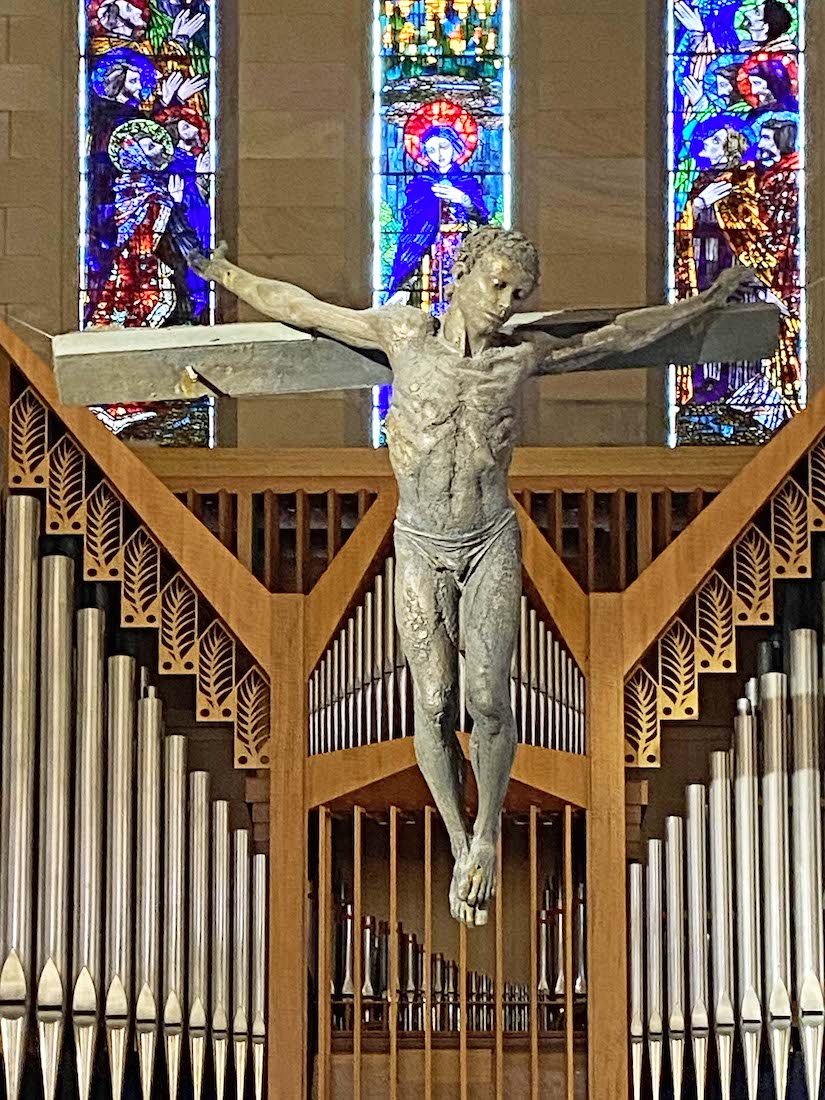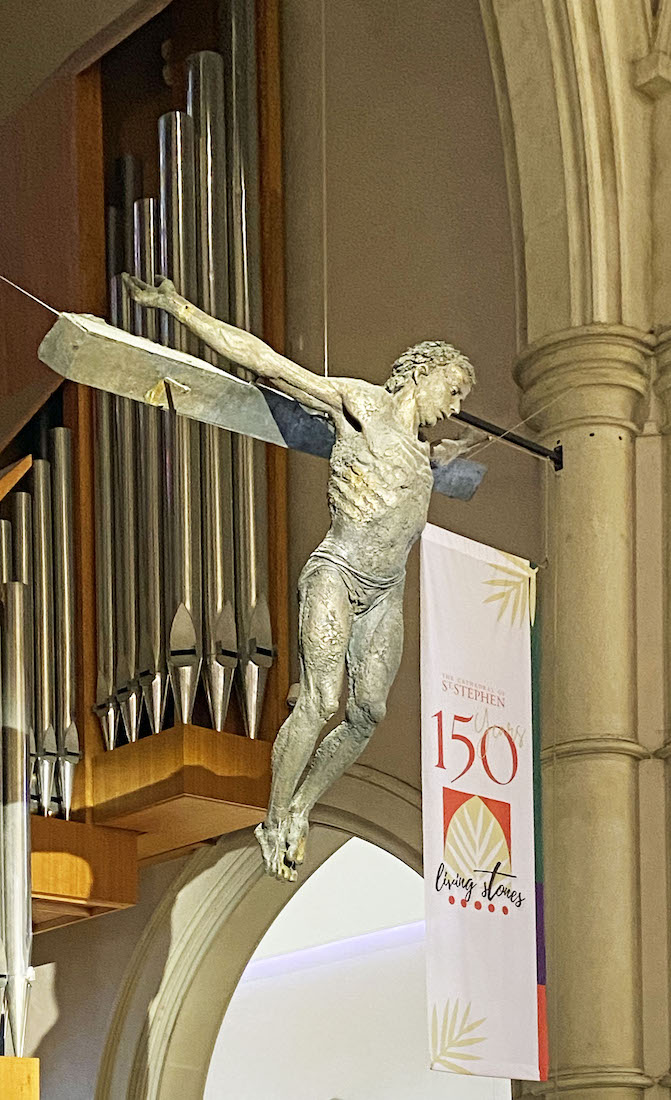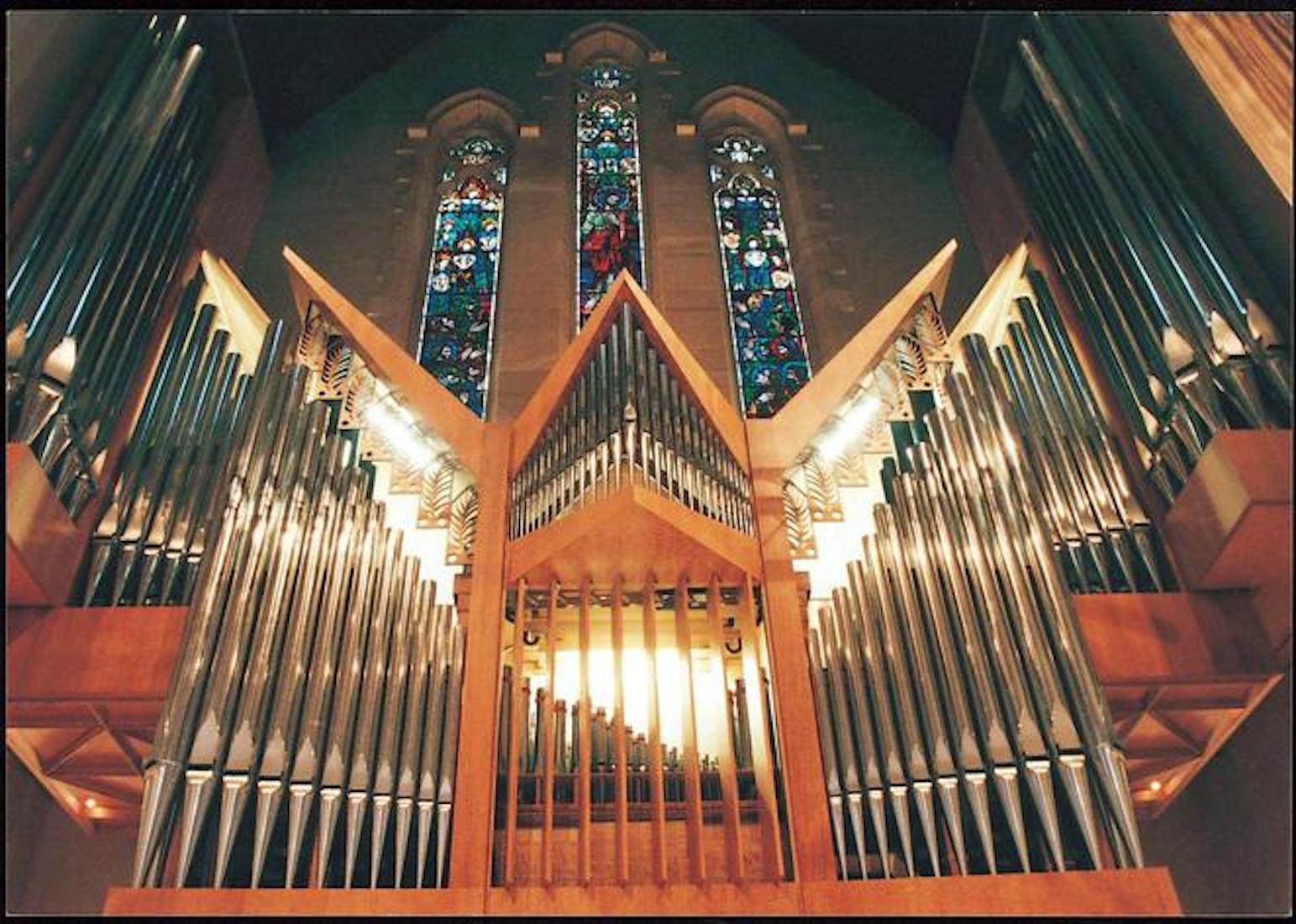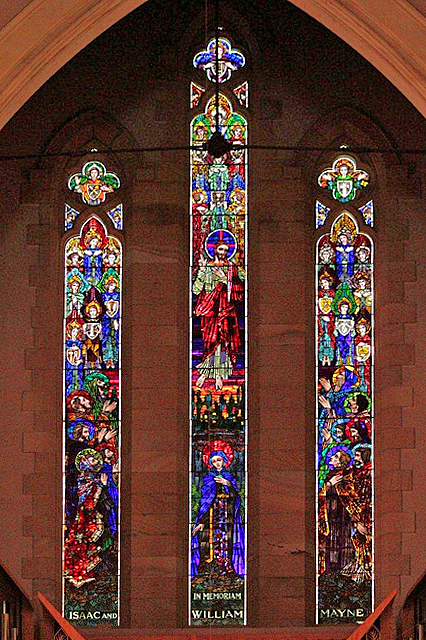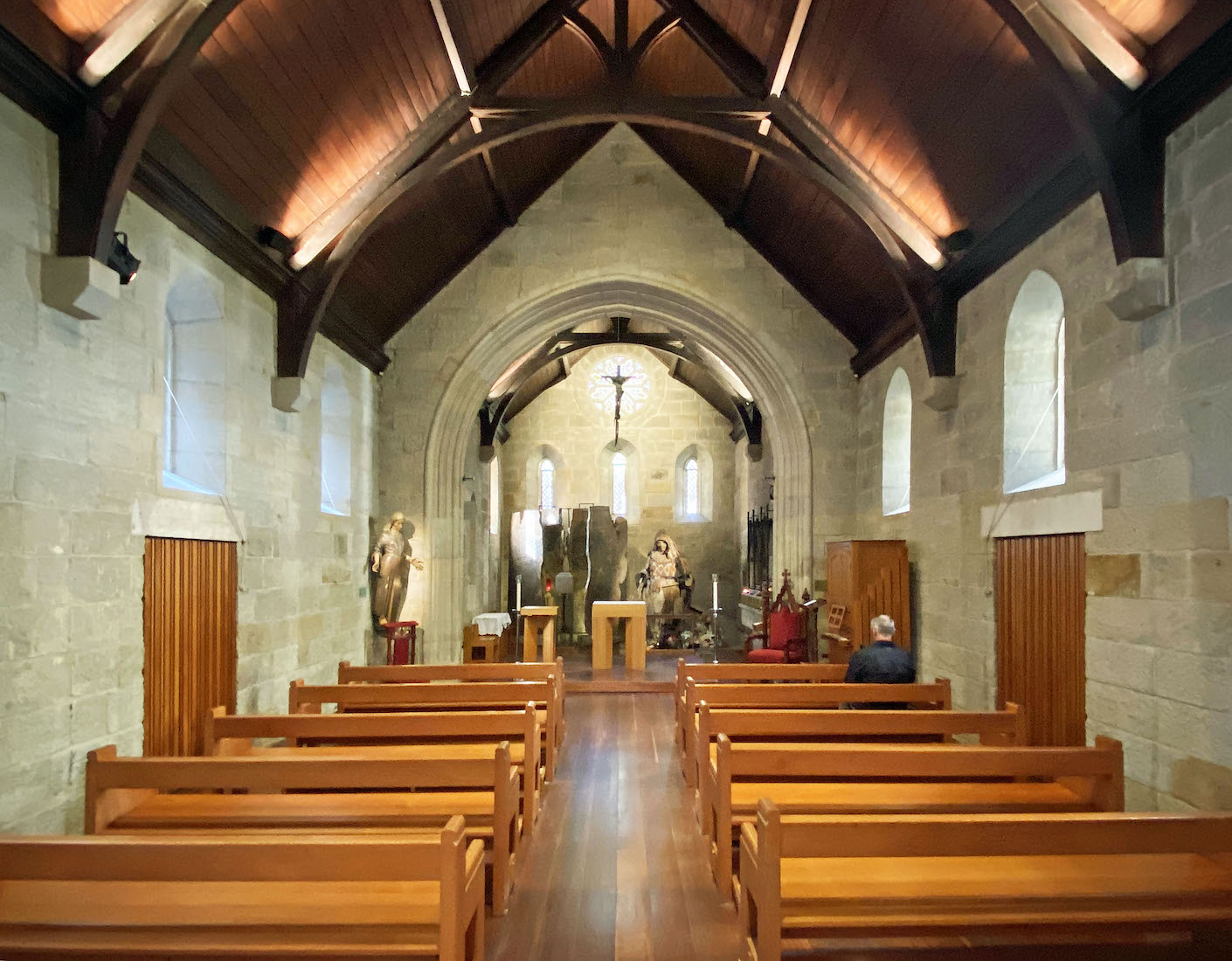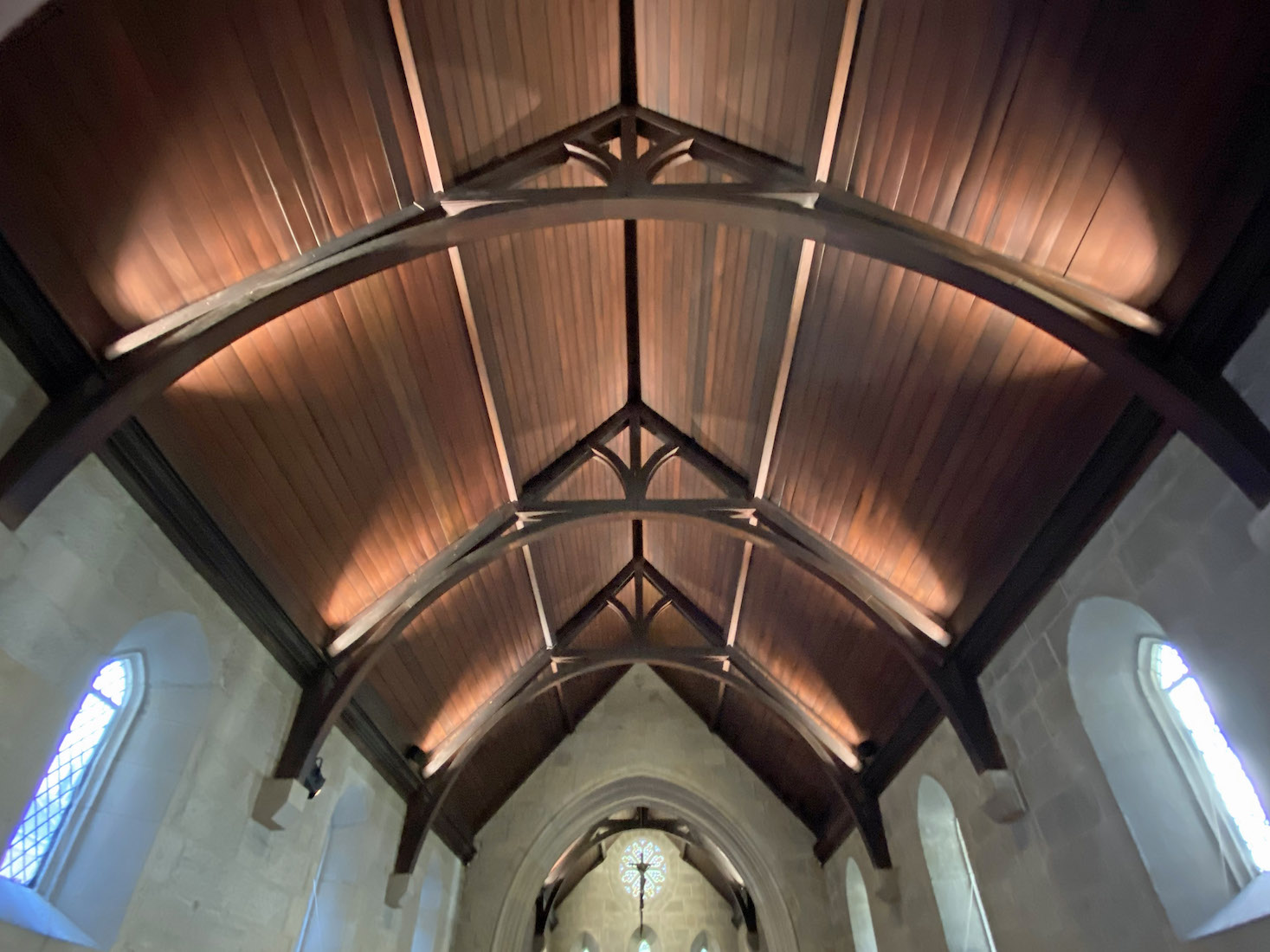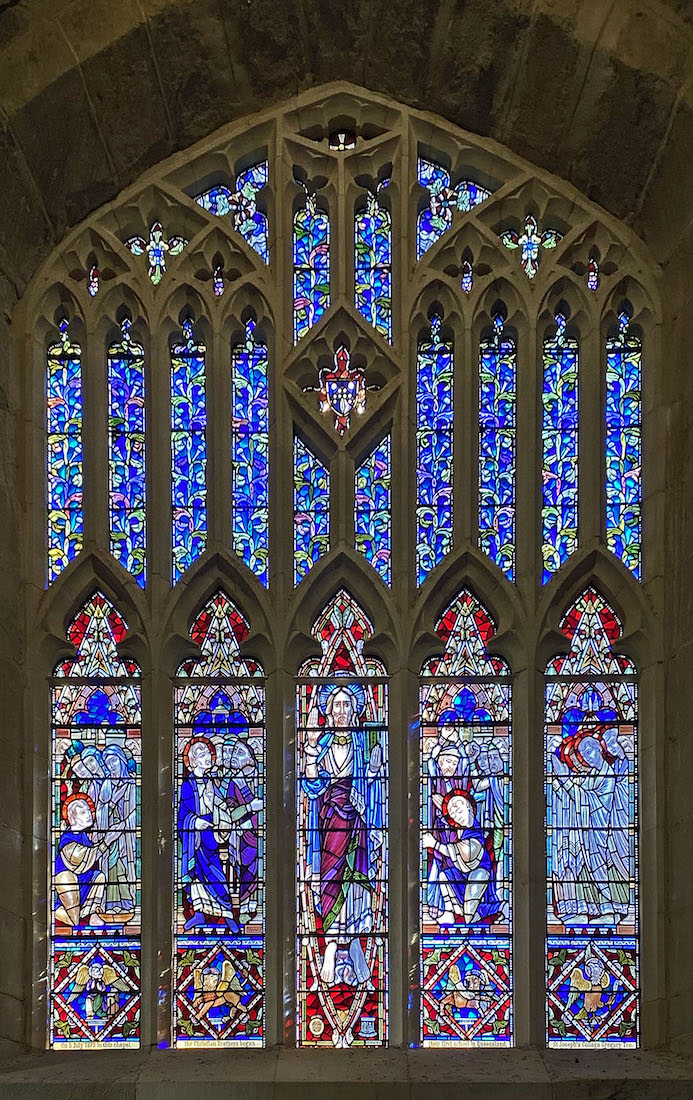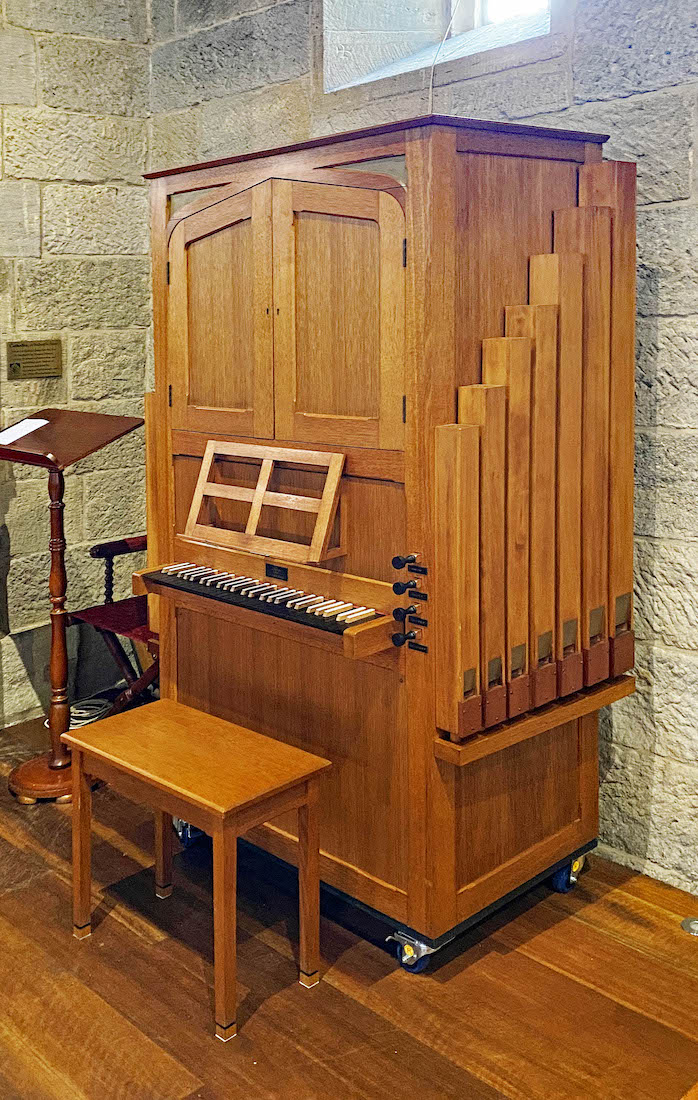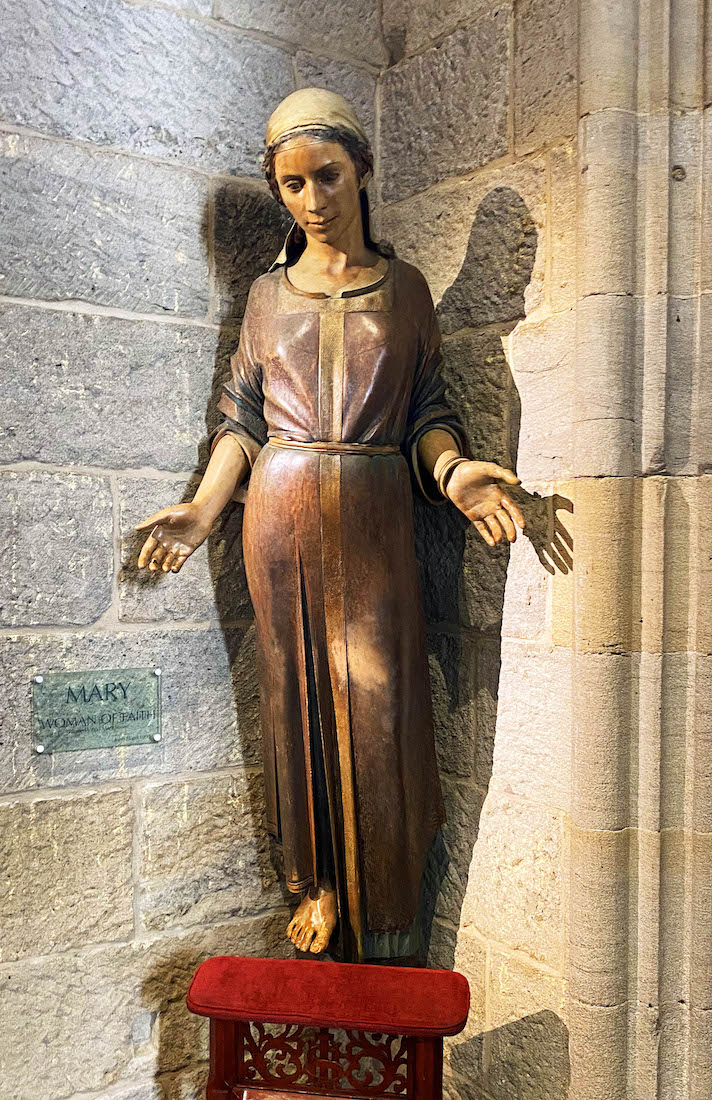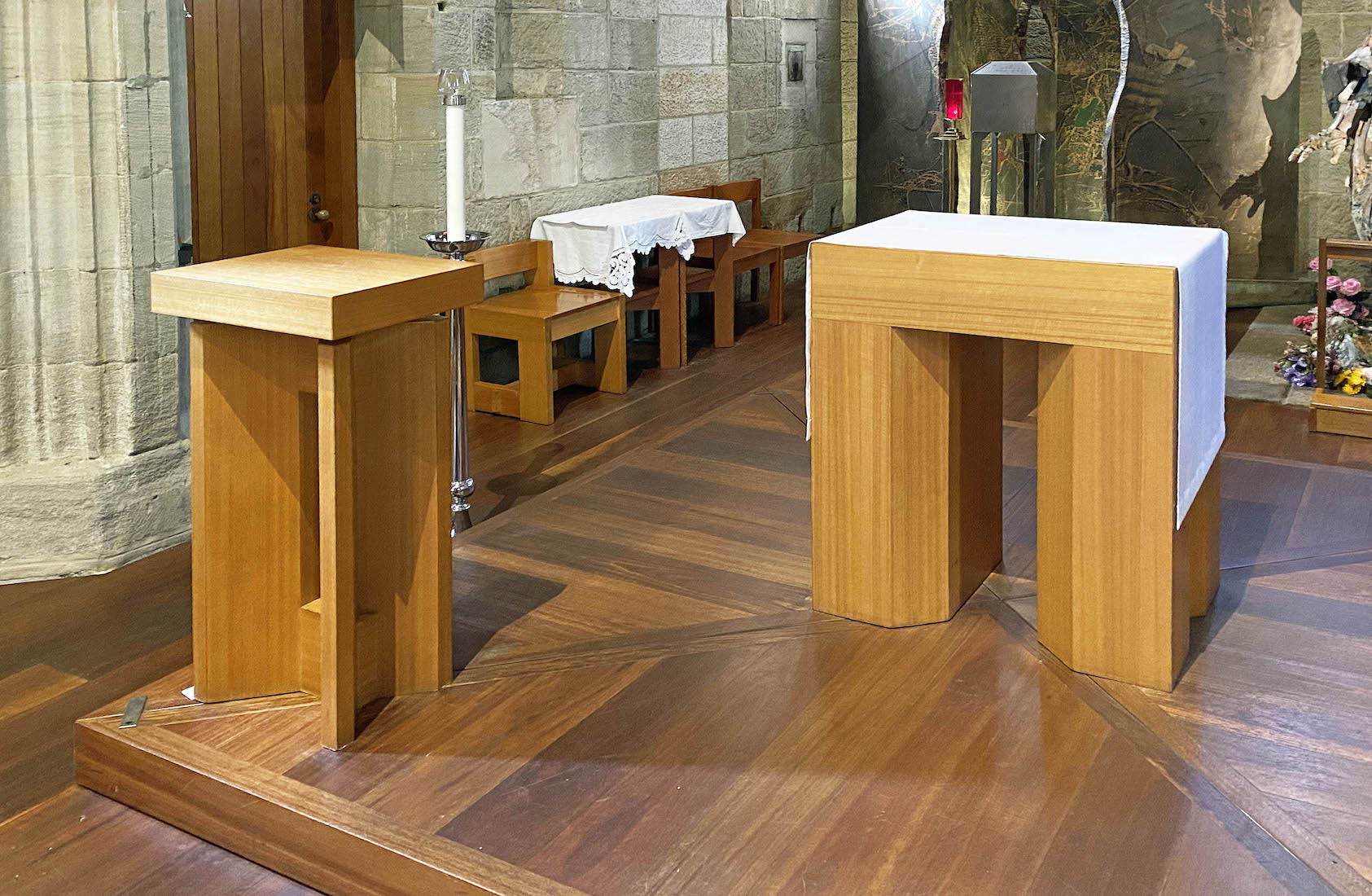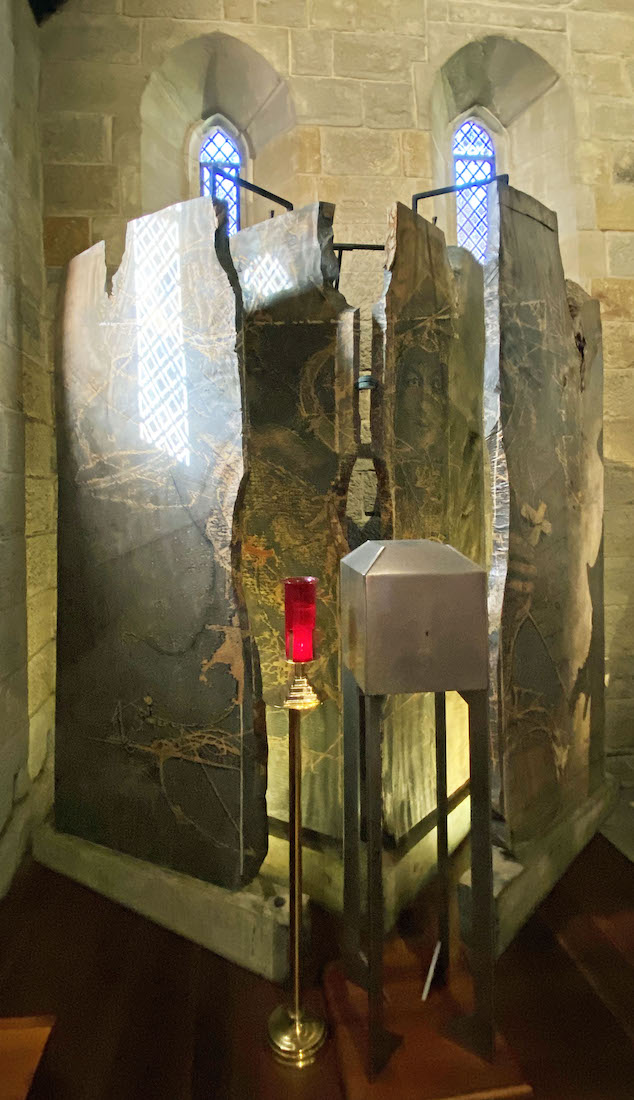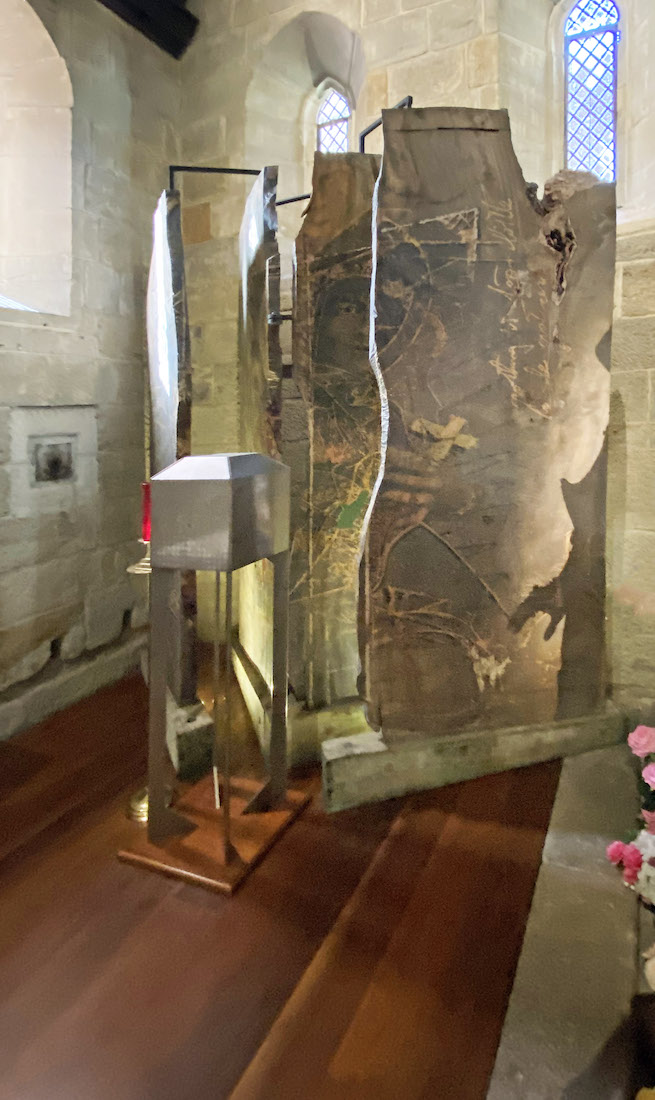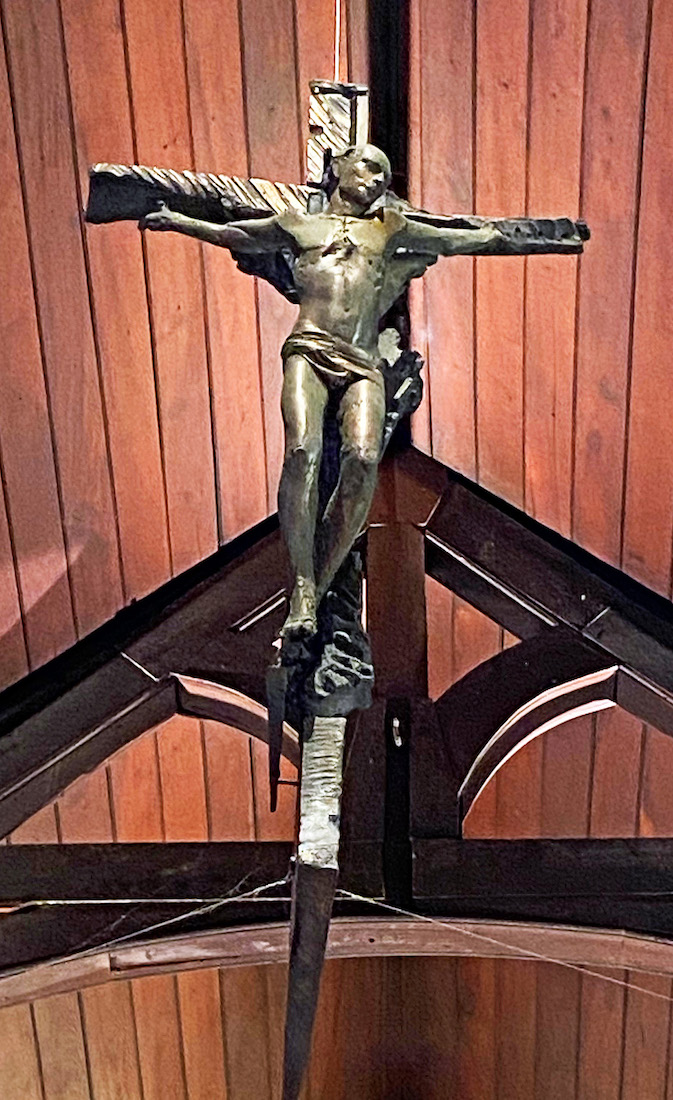
We move closer to the sanctuary in order to better enjoy this sacred space. We notice the nave altar with the cathedra behind, the organ, the crucifix and in the alse wall, the East window. INDEX
82. ALTAR
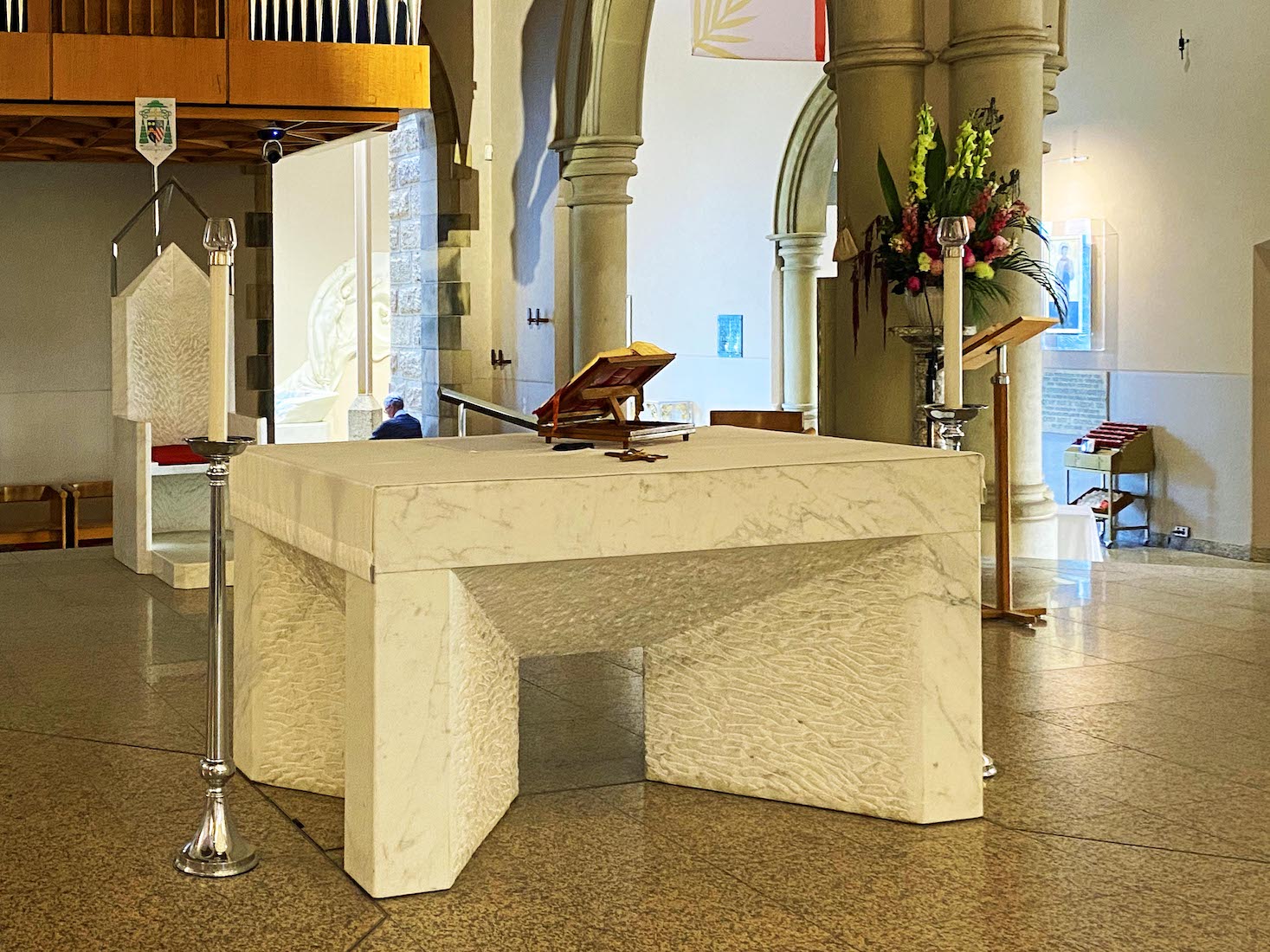
In the middle ages the altar was usually against the back wall of the sanctuary, and the priest began to celebrate the Eucharist with his back to the people. Today it is again free-standing and of a smaller, squarer shape. The altar, where the sacrifice of the cross is made present under sacramental signs, is also the table of the Lord. The people of God are called together to share in this table. The double aspect of altar and table is held together through the design of St Stephen’s altar and its change in texture.
83. CATHEDRA
The bishop’s chair echoes the simple form of ancient bishops’ seats from the early middle ages. It is surmounted with a steel frame which refers to the form of the bishop’s mitre and which evokes the presence of the bishop as chief pastor in his cathedral church. Another name for the bishop’s chair is the Latin ‘cathedra’, and it is from this that we get the word ‘cathedral’. So, a cathedral is where the bishop’s ‘seat’ or cathedra is.
84. CRUCIFIX
Suspended over the sanctuary, the bronze crucifix is the work of John Elliott. It captures Jesus' pain, suffering and death but also his strength, triumph and resurrection. In this way the crucifix seeks to express the whole of the Easter mystery. The cross can be viewed as a powerful sculpture not only from the front as most crucifixes are but also from the sides and from the rear.
85. ORGAN PIPES
Meticulously constructed by Victorian, Knud Smenge, to the design of architect Robin Gibson the organ array incorporates 2442 pipes and weighs 16 tonnes.The impressive case is made from imported mahogany and Victorian fiddleback mountain ash. [Photo Credit: Cathedral]
86. EAST WINDOW
The East window is one of the finest examples of stained glass in Australia. The work of Harry Clarke, it was commissioned by Archbishop Duhig on 10 June 1923. It is inscribed to the memory of Isaac and William Mayne. The window shows Christ standing on the clouds, ascending into heaven. The eleven apostles stand on each side and below stands Mary. In sorrow and desolation they look upward at the departing figure. In the upper portion of the window angels carry shields bearing the instruments of Christ's passion:In the left window, the spear and the reed with sponge, a club, the scourging pillar, a hammer and pincers. In the central window, the ladder, dice, nails and the cup of suffering. In the right window, the cross, the crown of thorns, a robe and a lantern. [Photograph Credit : Keith Gale]
87. ST STEPHEN’S CHAPEL
The building now provides the cathedral with a small-scale worship space. The seating and sanctuary can be rearranged so that it is suitable for the Liturgy of the Hours, small group masses, meditation groups, and weddings. The occasional spiritual talks or musical performances will also find a home in this sacred space. The whole of the worship space is located in the nave which is divided off from the apse by four solid timber panels and a rood bar with a crucifix in the midpoint.
88. CHAPEL ROOF
The timber aspects of this chapel, including the roof, make this a very warm, pleasing space.
89. VIEW TO THE WEST
Looking back at the West wall we note the colourful window, the West door, and the two (one!) stoups for holy water. The chapel is small – no room for a large congregation here. This is an advantage for a large cathedral: it is useful to have a small meeting place.
90. CHAPEL WEST WINDOW
The beautiful West window has a rather intricate design, with five lower panels of stained glass, and the window further subdivided above. n fact, the whole of the West window tracery design is evidently a simplified version of a window in Melrose Abbey, Scotland, which Pugin had seen. The remnants of the five-light tracery in the chancel east window at Melrose have an unusual cusped lozenge in the central light. Pugin, whose design details were not infrequently inspired by medieval work that he had recently studied and sketched, inserted such a lozenge in the central light of the West window for the plans used at Brisbane.
91. CHAPEL ORGAN
The organ was made by George Fincham and Sons of Melbourne, circa 1975. In 1998 the organ was rebuilt by Simon Pierce of Pierce Pipe Organs, Brisbane and installed in its present location soon after the rededication of the Chapel in 1999. The casework was completely remade in Tasmanian Oak, the soundboard reduced, and new pallets, keyboard and suspended action were fitted. All pipework was rescaled and revoiced, and much of the 8ft and 2ft ranks were completely replaced. Indeed, relatively little of the original instrument remains, and the resulting organ is essentially the work of W.J. Simon Pierce. Note the colours of the keys. In the 18th century, the keyboards of harpsichords, organs, cembalos, spinets and early pianos had black keys for the seven natural notes, and white keys for the five half-tone keys. From the early 19th century when pianos became much more popular and widely available, the colours were reversed. Having the seven naturals in white, and the half-tones in black, was preferred by manufacturers and players.
92. WOMAN OF FAITH
This statue of Mary Woman of Faith stands in the front left corner of the Chapel nave. It shows her standing with hands extended in trust, open to do the will of God. She draws the person who comes to pray into that same response of faith in God’s promises and trust in God’s goodness.
93. CHAPEL ALTAR SETTING
The Chapel altar and ambo are similar in design to their Cathedral counterparts, but fashioned in timber.
94. CHAPEL ROSE WINDOW
The chancel East wall has three narrow lancet windows, the central one being slightly taller than the others. These are plain with a diagonal lattice structure, and are surmounted by a traceried wheel window having eight spokes separating floral designed patterns of stained glass.
95. VIRGIN MARY FIGURE
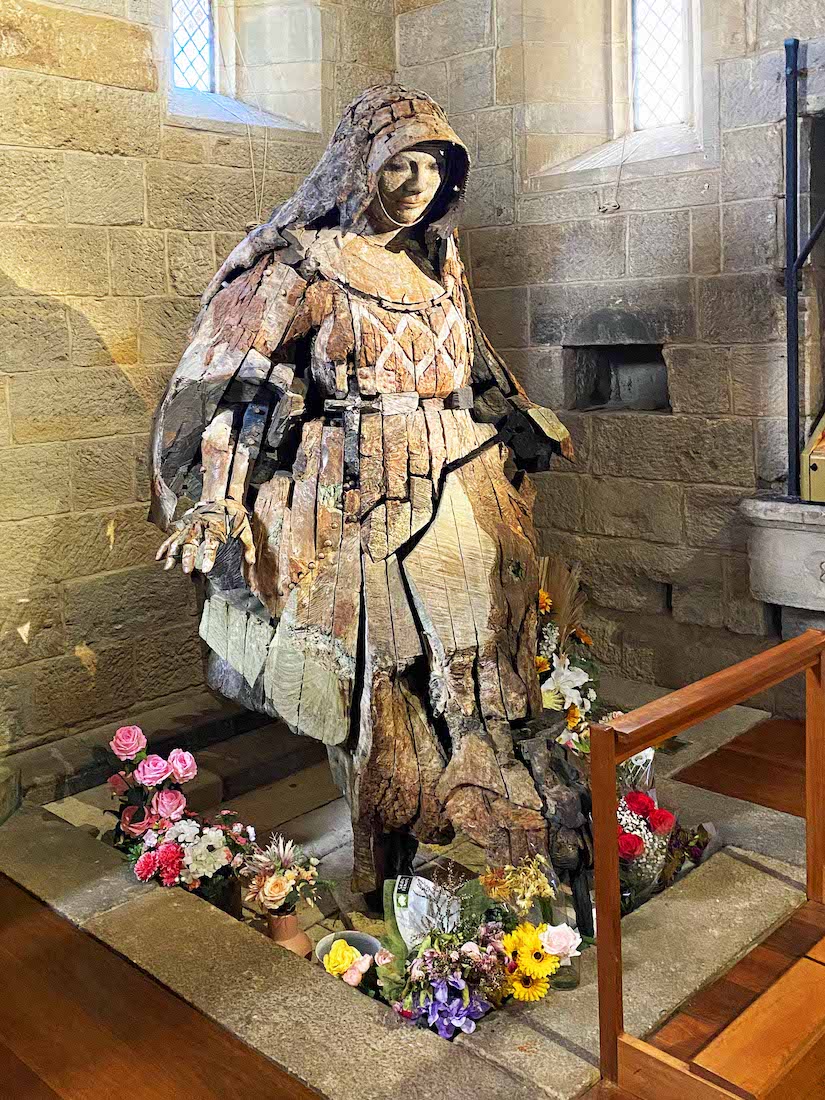
Mary MacKillop made more than eight trips to Brisbane and Queensland in her life establishing schools, convents and orphanages after arriving in Queensland in 1869. After being asked to leave Brisbane in the mid 1880s by Bishop James Quinn, the Sister of St Joseph, eventually returned in the early 1990s and set up five new schools around Rockhampton. Mary MacKillop prayed at the historic chapel at St Stephen’s during her first visit to Brisbane from 1869 to 1871, possibly while she lived at Kangaroo Point. ••• Brisbane sculptor, John Elliott, began with the trunk of a hundred-year-old camphor laurel tree. He sliced it and hollowed it out and then began painstakingly to recombine its elements, allowing the figure of Mary MacKillop to emerge. The ancient tree and its rough bark recall the slab hut in which she opened her first school, and the old fence posts she passed as she travelled through the Australian bush on horseback.
96. CAMPHOR LAUREL PANELS
The four panels near the shrine are the work of John Elliott. The drawing on the panels pay tribute to Mary’s religious life and her work encouraging the sisters in their ministry – especially by her letter writing. It also allows us to discover children, Australian animals and other elements of her life and ministry.
97. CHAPEL ROOD CROSS
A simple crucifix hangs between nave and sanctuary, serving the separating purpose of the traditional rood cross. Interestingly, the head of the figure on the cross is tilted to the (figure’s) left.
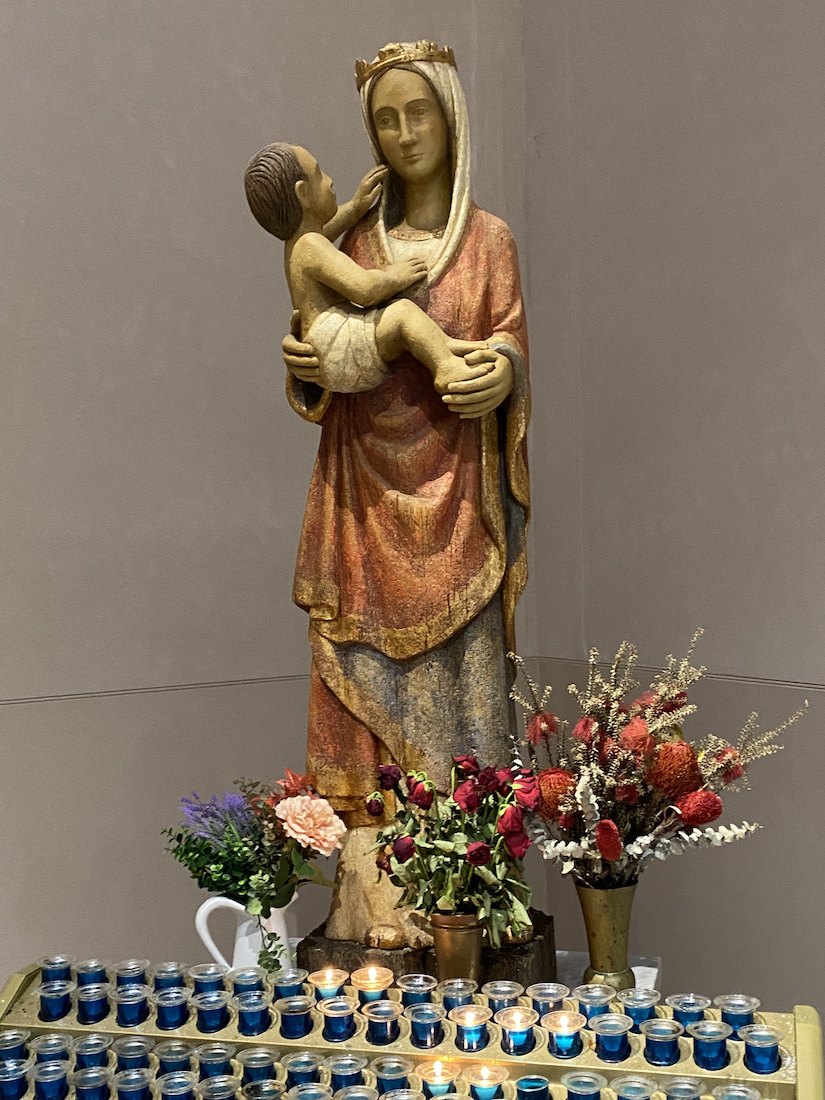
CONCLUSION
I hope you have enjoyed visiting St Stephen’s Cathedral with me. I have certainly enjoyed my visits! This is a splendid cathedral.
I am happy to receive any corrections or constructive criticism of this site. The best websites have no errors! I am grateful to my wife Margie who accompanied me to Brisbane, and has proofread these pages.
A collection of my photos used on this site can be found at
https://www.flickr.com/photos/paulscottinfo/albums/
The Cathedral website has link
http://www.cathedralofststephen.org.au
St Stephen’s was one of the earliest cathedrals (2012) I photographed in the making of many cathedral websites. I was never happy with the quality of my photos from that time, nor with the relatively small number! The present site is a complete remake of the first, and hopefully remedies those early deficiencies.
Original site created 08 / 2012; this site created 08 / 2023.
Paul Scott

